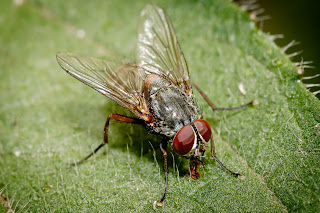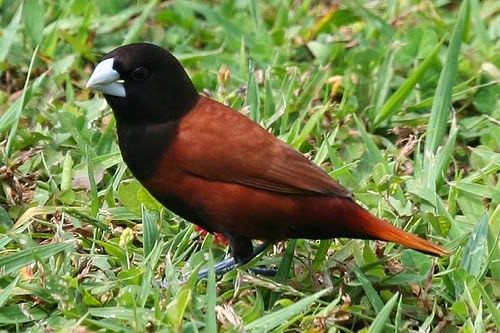Growing Threat of Biological Warfare - Sleeping Monster in the SkyDr Abe V Rotor The sky carries disseminants and innoculants of harmful bacteria, viruses, and other organisms - natural and man-made. With Genetic Engineering - the same process in making the Bt Corn, Bt cotton, Bt Soybean, SavrFlvr tomato, Golden Rice, and an ever increasing number of genetically modified plants, animals and microorganisms - we have tremendously increased the threat and gravity of biological warfare as the worst weapon of mass destruction - surpassing nuclear weapons, because biological agents, more so with those genetically engineered for high virulence and adaptability, may stay alive over a long period of time, and can reproduce tremendously to cover wide areas of doom.
- Severe Acute Respiratory Syndrome (SARS) invaded five continents before it was put off. It originated in China, where hundreds died. The disease found its way to the Philippines via Overseas Filipino Workers (OFWs) in Hongkong and Canada. The virus is believed to have mutated into a virulent and contagious form.
- Once the US Postal Service, to safeguard against anthrax, required its personnel to use gloves and masks when handling mail-sorting facilities in Washington, New York and New Jersey.
- As a precaution against biological warfare, the U.S. government has accelerated the delivery of smallpox vaccine, enough to inoculate every American. One drawback of this procedure is the possibility of unknown side effects when applied to people receiving medical treatments, such as chemotherapy.
- Escaped African killer bees (Apis mellifera scutellata) have interbred with domestic species creating an equally deadly hybrid that now threatens the United States, having spread throughout Brazil, Central America and Mexico. A colony is made up of some 70,000 ferocious insects with the queen bee reproducing at a rate of 5,000 eggs a day to maintain its enormous population.
- Escherischia coli is a common bacterial parasite of the intestine. Naturally occurring outbreaks of E. coli are the result of fecal contamination of hamburgers, water supplies and swimming pools, causing the hospitalization of hundreds of thousands of people each year.
These scenarios remind one of childhood days when many people survived smallpox epidemics. The center of the epidemic was Lapog, Ilocos Sur, atown whose population was decimated. The mere mention of its name brings sad memories of the early 1900s’ disaster. Lapog was so associated with the dreaded disease, they later renamed it San Juan.
The author’s forebears suffered this disease. Of eight siblings in the author’s paternal side of the family, only two survived the disease. Uncle Leo, the eldest miraculously survived. His dad, the youngest, was born after the epidemic had subsided.
Visibly, faces of survivors are covered with pockmarks. But so are their entire bodies, arms and legs, including the ears, nose, eyelids and lips that become somehow disfigured. In serious cases, fingers and toes are also deformed.
Despite of their traumatic experiences, survivors continue to live normal lives. Psychologists say there are many survivors of tragic experiences who find the new lease on life. Stories of how entire communities gather to support survivors uplift spirit.
Conquest and Diseases
Christopher Columbus and his men allegedly introduced a very contagious disease, syphilis, in the New World. The meeting of East and West during the era of colonization also resulted in the exchange of diseases. James Michener’s novel, “Hawaii,” relates how smallpox caused death and suffering to the natives. To the novel’s principal character, the Reverend Hale, it was a manifestation of God’s wrath on the sinful pagans. While this incident helped him in his mission, the end proved that the English missionary was wrong, that God is not a God of vengeance.
Whole settlements in the New World just perished as a result of indigenous diseases that were unknown in their countries of origin. Scientists explain that these pioneers lacked the natural immunity to the diseases. The same lack of immunity from diseases introduced into the Old World is what killed many people. This is the reason why the World Health Organization and many countries require the vaccination of travelers against certain diseases as a requirement prior to obtaining passports and visas.
These are incidents we can dismiss as force majeure, which our culture can accept. But what about the case of war when nation is pitted against nation?
Man’s Inhumanity to Man
Throughout history, war has been the scourge of man, the evidence of man’s inhumanity to man. It is the antithesis of culture and civilization that are supposed to uphold the dignity of man and his society. Ironically, war has plagued every civilization, and many great civilizations were the centers of human conflict. According to the historian, Gibbon, twelve great civilizations, that include the Greek and Roman civilizations, fell because of war.
History is replete with cases where the more civilized societies were instigators of the loss of peace, if not the destroyers of the less civilized ones. The great Spanish conquistadores destroyed the great civilizations of the Aztecs and the Mayas in South America, in the same way that the pioneers of the United States destroyed the civilizations of the native Americans.
Early Biological Warfare
Carthage, a thriving agricultural and trading center during the Roman times, became swampland, then subsequently a desert, as we know today. How did this happen? The invading Romans drew saltwater from the sea and used it to flood settlements and farmlands, thus putting an end to the powerful enemy.
“How The West Was Won,” is a story of the destruction of the American Indian civilization which had been flourishing for many centuries prior to Columbus. The natives fought fiercely at the European invaders and defended their “nation” for years. But the pioneers knew the key to their victory over the powerful Indian tribes was to annihilate the buffaloes. Millions of them once roamed the Great Plains, or what is known as the prairies. Because buffaloes provided the Indians their basic needs for food and shelter, famine ensued and the great American Indian civilization was ultimately reduced into marginal settlements. Buffalo Bill is reported to have killed more than three hundred buffaloes in a single day, for which he earned his reputation.
What if China had sent a million soldiers to fight and die in Vietnam during the Chinese-Vietnam conflict? The task of burying the dead alone, while controlling pestilence that would have ensued, would be enough to defeat the enemy. On the part of China, such massive death would reduce pressure on its burgeoning population, while ridding the society of some misfits. It is not so, but many people believe that war is a purification process. The Germans lost thousands of scientists and potential nation-builders during World War II. Many American soldiers who died in the Vietnam War were among the finest young men of their time.
But man has not learned his lessons well. War is at its ugliest when chemicals, biological agents, nuclear and other weapons of mass destruction are used. For nuclear arsenals alone, the world’s total stockpile has the capacity to kill three times the total global population. The world is witness to the recent wars in Iraq. Wars in Bosnia, Macedonia, Uganda, Angola and Afghanistan still bear ugly scars. War is also taking place in Sri Lanka against the Tamil Guerillas, between Pakistan and India along their disputed border, Spain against the Basques guerillas, Britain against the IRA in Northern Ireland, and the Philippines against the Abu Sayaf and the New People’s Army (NPA).
War Without Borders
Something unexpected and different happened. On September 11, 2001 the World Trade Center, a 110-storey twin-tower complex was erased from the skyscape of New York City in matters of minutes shortly after two planes, commandeered by terrorists, smashed into the superstructures. It challenged the economic powers of the world, particularly America to wage a war without borders against terrorism.
The world woke up to a new era of cross-border terrorism with invisible organizational network of cells distributed throughout the globe.
In this kind of war, the intrusion into an enemy’s territory, or the definition of the locus of battle, do not follow the conventional rules. In fact there are no specific rules when we refer to the modus operandi of terrorists. Rules of engagement changed after September 11.
Biological Warfare
First there was anthrax, the most serious and the first to hit the headlines after the bombing of the World Trade Center. It leads a dozen of similarly devastating cases of biological warfare strategies.
Second, there is an attempt to revive bubonic plague that killed one-third of the world’s population in the Middle Ages. It was the Japanese who experimented in the making of bubonic flea bombs intended to spread the plague in major USA cities. The project was to breed the fleas which harbor the plague bacteria in its body, then scatter these to infest rats and other animals in the target area where they in turn multiply and transmit the pathogen to the residents. The bomb was successfully tested in China with hundreds of Chinese succumbing to the bubonic plague bacteria. Preparations were then made to attack the U.S. But the U.S. dropped the atomic bombs on Hiroshima and Nagasaki first. Japan hastily removed all the evidences of its evil experiment even before its surrender to the US.
Third, the threat of influenza which killed millions of people early in the 2oth century, has caused alarm in the 1980s after scientists discovered a new virus hybrid of the chicken and human influenza viruses. Based on the ratio of victims to population during the first epidemic, scientists believe that some 60 to 100 million people could die of the new influenza virus strain should it strike again.
Biological warfare intends to use germs with a history of epidemic-spreading capabilities. Here is an outline of the basic facts about these important potential epidemic diseases.
Anthrax
• Anthrax is also known as malignant pustule, malignant edema or woodsorters’ disease.
• It is most common in South America, Australia, Africa and Russia.
• It is a highly infectious disease, affecting animals. It occurs in cattle, sheep, horses and mules.
• It is transmitted to humans through contact with any part of the animal carrying the infectious agent.
• It is caused by Bacillus anthracis, whose spores are resistant to disinfectants and heat. It may remain infectious for up to 15 years in the soil. Grazing animals can accumulate spores contained in the droppings of infected animals.
• Humans acquire the disease through skin cuts or wounds, by eating infected meat, or by breathing in the spores contained in the dust emanating from the sick animal’s hide or hair.
• Skin infection is characterized by severe itching and appearance of boils, usually on the arms, face and neck. The inflamed area grows into an ulcer called a malignant pustule, which eventually bursts and produces a black scab. Fever, nausea and swelling of the lymph glands are accompanying symptoms.
• Internal anthrax acquired through inhalation results in acute pneumonia. When infected meat is ingested symptoms of acute gastroenteritis occur.
• Anthrax is effectively treated with antibiotics. Immunization against the disease has been made possible through the use of vaccine. Effective livestock management is key to the control in the spread of the disease.
Bubonic Plague
• It is known as the Black Death in the Middle Ages which ravaged Europe and Asia.
• In some places as many as two-thirds of the entire population have died
• It is so-called from the blackening spots which cover the skin during the course of the disease.
• Characteristic symptoms are fever and swelling of the lymph nodes, mainly the groin and armpit areas.
• It is caused by the plague bacillus (Pasteurella pestis) which is transmitted from rats (Rattus rattus norvigicus) to humans through flea (Xenopsylla chopis).
Small pox
• This is a highly contagious disease, often fatal, that ravaged populations in the past. Just one infected person could cause the virus to radiate from a family to a neighborhood, and to a city in a matter of months.
• Smallpox cannot be treated effectively once symptoms begin. Around 30 percent of those infected will die.
• WHO declared the eradication of smallpox in 1980. Routine immunizations to protect against the disease were stopped as early as 1971.
• First signs are: chills and high fever, severe headache and backache, followed by rashes which eventually cover the entire body and turn into pus-filled blisters.
• The blisters, in turn, dry up to form scabs which very often leave pockmarks.
• The disease may be accompanied by vomiting, convulsion and diarrhea. Complications include other skin infections such as boils and abscesses, ear infections, pneumonia and heart failure.
• The disease is not transmitted by animals.
• It has been eliminated through world-wide vaccination programs, although a mild form still exists in Ethiopia.
• The disease has been largely eliminated by extermination of rats. Antibiotics such as oxytetracycline, streptomycin and chloramphenicol are effective in its treatment.
________________________________________________________________
Biological agents also include Tularemia, a bacterium, classified pneumonic and septic - if untreated, has a mortality rate of 30 to 40 percent; boutinium, a toxin from a bacterium, that has 60 to 100 percent mortality; and ricin, a deadly toxin from castor bean (Ricinus communis).
________________________________________________________________
Other Potential Bio-Warfare Organisms
There are many organisms which can be used in biological warfare. A terrorist attack aimed at crops and livestock would be less dramatic but might cause more disruption in the long run.
Potato Blight – This fungus-caused plant disease is also called late blight, a worldwide serious disease of potato and tomato in cool humid countries. The fungus is the Phyhtopthora infestans. In Ireland, 30 percent of the population starved to death, the other dying of typhoid fever that followed. Still others emigrated to America from 1845 to 1860. Tomato blight caused by the same fungus destroyed 50 percent of the crop in Eastern US in 1946.
Rust Fungi. There are species of Puccinia affecting cereals. Among them is Puccinia graminis tritici, one of over 200 fungal races which attack wheat. Although rust fungi can only complete their life cycles in the presence of alternate hosts, such as barberry in wheat rust, its potential use for biological warfare is great considering that cereals comprise the staple of the mankind. The narrowing down in the number of cereal varieties used for commercial production exposes croplands to greater danger of exposure to rust diseases and therefore, widespread destruction.
Salmonella - In 1984, a cult in Oregon set off a wave of food poisonings. Gastroenteritis, caused by natural contamination and careless food handling, afflicts millions of people, causing about 5000 deaths per year. Salmonella, along with typhoid and paratyphoid germs, belong to a large group of rod-shaped bacteria that invade the gastrointestinal tract. Antibiotics are recommended to combat Salmonella infection.
Foot-and-Mouth Disease. This disease affects hoofed animals like hogs and cattle, and is naturally occurring worldwide. FMD usually hits the Philippines in the summer months. Although the pathogen is not generally transmitted from animals to humans, losses incurred are usually heavy. Infected animal are economically worthless. Their carcasses are burned to prevent infection. Quarantine and an extreme form of sanitation are the best defenses against the spread of the disease.
Mad Cow Disease. The disease is called bovine spongiform encephalopathy or BSE. In 1996, it was determined to infect humans in the form of a new variant of Creutzfeldt-Jakob Disease (CJD). Eighty people in Britain have died of CJD, and there is no data yet to show how many more will suffer because there are initial signs of acquiring the disease that are not clear. Besides, the gestation period of the disease is up to 15 years.
Other biological warfare agents include potato beetles, which Britain suspects the Germans dropped during the war in small cardboards bombs filled with the pest. In the 1980s, Tamil militants threatened to target Sri Lankan tea and rubber plantations with plant pathogens.
HIV-AIDS. To date, 17 million people around the world have died of Acute Immuno-Deficiency Syndrome (AIDS). The epidemic started at the lower quadrant of Africa. The irony of AIDS is that both strong and frail are potential victims. There are 3.7 million children who have died of AIDS, and it has orphaned 12 million children.
An estimated 8.8 million adults in Africa alone are infected with HIV/AIDS and in the seven countries in Africa one out of five people are living with HIV, while 3.8 million Africans are infected every year. There are 36 million adults and children in the world living with HIV/AIDS. Bioterrorism may be eyeing at the spread of the disease in the industrialized countries through blood donations and immunization channels.
Ebola. This is a highly virulent disease caused by a virus that originated in Africa, infecting humans and primates. Much of the information about the disease is still a mystery, but one thing is sure: the fatality rate is very high once a person gets the virus.
Through skin contact and even only through inhalation, the virus can be acquired easily. One incident is about the case of a member a religious congregation, who had been treating Ebola patients, suddenly dying of the disease herself. Ignoring warnings, other members attended her funeral, causing one of them to acquire the virus and dying later.
African Giant Snail (Achatina fulica) was brought by the Japanese to the Philippine during World War II. Now it is a pest of garden and field crops. Damage can lead to severe crop losses. The pest persists but seldom develops into epidemic proportion. The introduced Golden Kuhol (Pomacea caniculata), thought to provide a livelihood for farmers, became a major pest affecting half of our lowland ricefields.
Protection Guidelines
Here are guidelines to protect yourself against possible biological warfare attack.
1. Keep distant from possible sources of biochemical materials such as spores of the deadly anthrax. Be wary of suspicious parcels.
2. Get help from authorities to get rid of suspicious-looking materials.
3. Be familiar with the locations of Bomb Shelters. Such shelters are found in big cities like New York, Tokyo and Tel Aviv. We do not have one in Manila, but there are places and buildings where you can find temporary shelter in case of attack.
4. Don’t loiter in centralized air-conditioned places like malls. Avoid crowds and busy streets if you can.
5. Early symptoms should be treated immediately by a doctor. Anthrax for example has flu-like symptoms.
6. Keep your body resistance high at all times. Good rest, balanced diet, and regular exercise are key to resistance against diseases.
7. Don’t be a victim of psychological war. Terrorism thrives on it. We have yet to coin a word for biochemical phobia.
8. Like Boy Scouts, remember “Always be Prepared”. Equally important is to be ready to help other people.
On September 11, 2001, many people thought Third World War had started. Then came Afganistan and Iraq wars. These incidents have sparked real and psychological fear around the globe. In our modern world, an all-out war is likely to employ all kinds of weapons of mass destruction from chemical to biological – and worse, to thermonuclear annihilation. Since there are no defined borders, everyone is a potential victim. It will be difficult to detect the enemy and the tools of war he will use. The “morning after” exposes further destruction. Nuclear radiation takes a long time to dissipate. It means that radioactive materials will continue to kill and maim long after the explosion. Even to this day, there are people dying in Japan due to the atomic bombs dropped there 45 years ago.
This long life after-effect is also true with bacterial spores. These organisms have the capacity to re-infect and cause a second wave of epidemic. Even after the white flag is raised to end the war, still many people continue to get sick and die.
In the early 1960s, as a member of the extension program at the University of the Philippines at Los Baños, then UP College of Agriculture, the author was involved in promoting modern agriculture to farmers. Among the farm chemicals he handled were herbicides. By coincidence, the U.S. was also developing at that time a chemical called Agent Orange which later was used in Vietnam. While this chemical can maim or cause death, its intended use is that of defoliant. By spraying the chemical on forests, trees lose their leaves, in fact their entire crown. When this happens a jungle can easily catch fire, making it easy to flush out the Vietcong guerillas from their hideouts.
It was his first encounter with biological warfare. The memory does not only linger, it remains fresh. ~
 4. I love insects for the resin they produce with certain plants which is used in worships, to bring the faithful to their knees, similarly to calm down fowls on their roost, drive vermin or keep them at bay, pacify and make peace with the unseen spirits;
4. I love insects for the resin they produce with certain plants which is used in worships, to bring the faithful to their knees, similarly to calm down fowls on their roost, drive vermin or keep them at bay, pacify and make peace with the unseen spirits; 10. I love insects for disposing garbage, of bringing back to nature organic compounds into elemental forms ready to be used again by the succeeding generations of living things.
10. I love insects for disposing garbage, of bringing back to nature organic compounds into elemental forms ready to be used again by the succeeding generations of living things. 11. I love insects for play, and for lessons in life - how they jump and fly, carry tremendous load which I wish I could, how they practice frugality, patience, fraternity, and how they circle a candle one lonely night and singed into its flame that inspires heroism and martyrdom;
11. I love insects for play, and for lessons in life - how they jump and fly, carry tremendous load which I wish I could, how they practice frugality, patience, fraternity, and how they circle a candle one lonely night and singed into its flame that inspires heroism and martyrdom;




































+A.jpg)







.jpg)






































